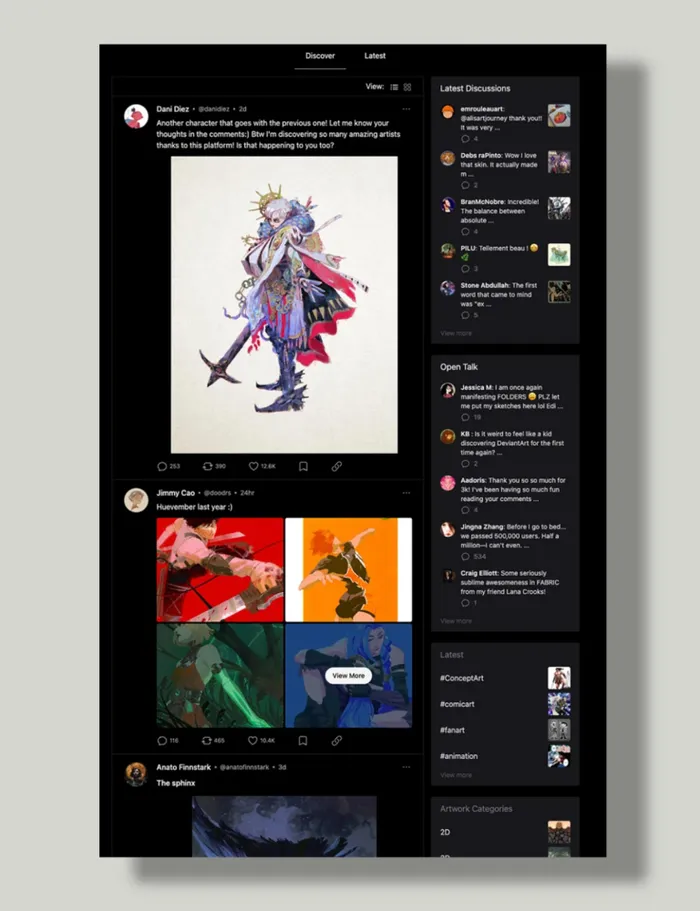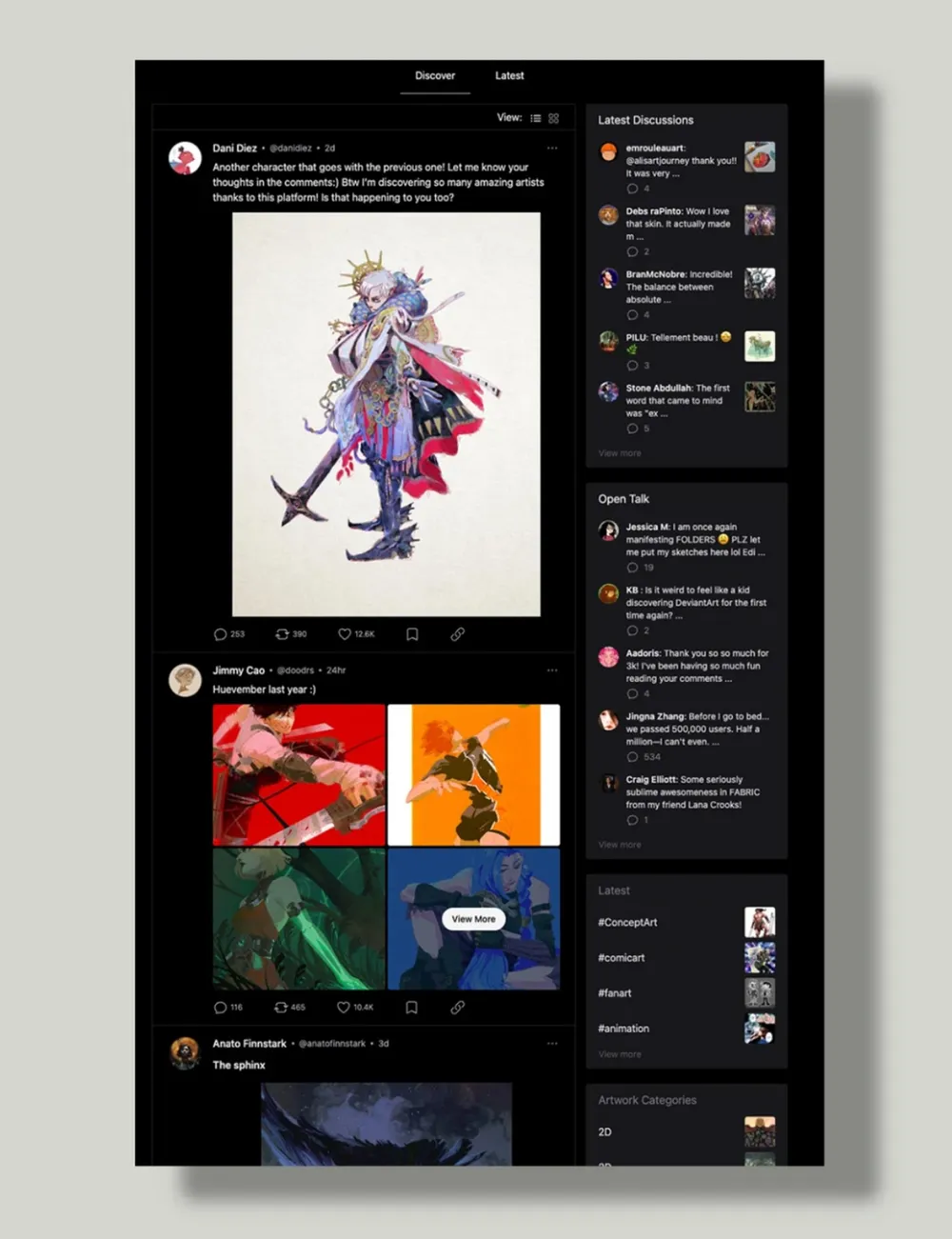
In the last few months, Meta started to sneakily train its generative AI tool on Instagram posts. Now, some artists are jumping ship to a lesser-known portfolio app, Cara, to protect their work from AI data scrapers.
The portfolio app bills itself as a platform that protects artists’ images from being used to train AI, and only allowing AI content to be posted if it’s clearly labeled. Based on the number of new users the Cara app has garnered over the past few days, there seems to be a need. Between May 31 and June 2, Cara’s user base tripled from less than 100,000 to more than 300,000 profiles, skyrocketing to the top of the app store.
Here’s everything you need to know about the Cara app, including its key features, how it claims to protect artists’ work from AI scrapers, and its skyrocketing popularity.

WHAT IS THE CARA APP?
Cara is a social networking app for creatives, in which users can post images of their artwork, memes, or just their own text-based musings. It shares similarities with major social platforms like X (formerly Twitter) and Instagram on a few fronts. Users can access Cara through a mobile app or on a browser. Both options are free to use.
The UI itself is like an arts-centric combination of X and Instagram. In fact, some UI elements seem like they were pulled directly from other social media sites. (It’s not the most innovative approach, but it is strategic: as a new app, any barriers to potential adoption need to be low).
On the iOS app, the main page lets you toggle between “Home” and “Following” feeds, both of which look basically identical to the format on X. Scrollable posts appear one at a time, with photos or text on top and a bar below that includes comment, repost, like, bookmark, and link functions (visualized with the same icons, like a heart, you’d see on X). There’s also a search page, displayed in a colorful grid, that looks analogous to Instagram Explore—except, of course, every square is some kind of artwork.
WHAT ARE CARA’S DIFFERENTIATING FEATURES?
While a good chunk of the Cara app’s UI seems to mimic that of existing social platforms, the app does introduce several of its own unique features.
Users can customize their home feed by deciding what percentage of posts they’d like to see from people they follow, their network, and the site at large. It’s also possible to keep text-based posts separate from a user’s portfolio, so that professional discourse and fandom memes can live in different places.
Perhaps most notably, Cara has a LinkedIn-esque job tab to help companies discover artists and vice-versa. Relevant job postings for positions like game designer, VFX artist, and animator are listed under the tab and link out to the associated companies.

Cara isn’t necessarily introducing any ground-breaking technological advancements. What it is offering, though, is an escape button for artists to bail from the increasingly hellish and prohibitive creative environment on Instagram.
In recent months, Meta began mining Instagram images and videos to train its artificial intelligence models on the social media platform’s content. Users were alerted via a small pop-up on the app, and it’s impossible to opt out of the AI training unless you’re in the European Union (even then, Meta has made it as confusing as humanly possible to turn off the function). The news has spread in the past week or so as general ire over Meta’s handling of the feature gains traction.
This development has major implications for artists on Instagram, especially those who rely on the app as a source of income. They face the choice of letting any of their posts be taken and used for AI training—which could presumably then recreate their art without permission in the future—or abandoning the revenue stream altogether. Some are choosing the latter.
HOW DOES CARA PROTECT ARTISTS FROM AI DATA MINING?
Cara doesn’t train any AI models on its content, nor does it allow third parties to do so. According to Cara’s FAQ page, the app aims to protect its users from AI scraping by automatically implementing “NoAI” tags on all of its posts. The website says these tags “are intended to tell AI scrapers not to scrape from Cara.”
Ultimately, they appear to be html metadata tags that politely ask bad actors not to get up to any funny business, and it’s pretty unlikely that they hold any actual legal weight. Cara admits as much, too, warning its users that the tags aren’t a “fully comprehensive solution and won’t completely prevent dedicated scrapers.”
With that in mind, Cara assesses the “NoAI” tagging system as a “a necessary first step in building a space that is actually welcoming to artists–one that respects them as creators and doesn’t opt their work into unethical AI scraping without their consent.”
Issues with generative AI models taking images without consent are currently being duked out in U.S. courts. As recently as April 29, Google was sued by a group of artists—including Zhang herself—for using their work to train its AI image generator without consent.

In December, Cara launched another tool called Cara Glaze to defend its artists’ work against scrapers. (Users can only use it a select number of times.) Glaze, developed by the SAND Lab at University of Chicago, makes it much more difficult for AI models to accurately understand and mimic an artist’s personal style. The tool works by learning how AI bots perceive artwork, and then making a set of minimal changes that are invisible to the human eye but confusing to the AI model. The AI bot then has trouble “translating” the art style and generates warped recreations.
In the future, Cara also plans to implement Nightshade, another University of Chicago software that helps protect artwork against AI scapers. Nightshade “poisons” AI training data by adding invisible pixels to artwork that can cause AI software to completely misunderstand the image.
Beyond establishing shields against data mining, Cara also uses a third party service to detect and moderate any AI artwork that’s posted to the site. Non-human artwork is forbidden, unless it’s been properly labeled by the poster.
WHY IS THE CARA APP GAINING SUDDEN POPULARITY—AND WILL IT LAST?
Early last week, Cara had only a few thousand profiles. But in the past few days, Instagram users like Disney animator Aaron Blaise began posting links to their new Cara profiles on their stories, with some even deleting all of their old content and migrating to the new app.
The trend took off. Zhang posted on Cara that the app had hit 100,000 users on May 31, surpassed the 300,000 mark by June 2, and climbed to a top five spot on the app store—boxing out Twitter, Discord, Reddit, LinkedIn, and Messenger.
But the app’s meteoric rise to fame has come with plenty of bumps. To start, Cara is still in beta, meaning that its small team of developers were working through existing issues even before hoards of new users showed up. Zhang wrote on Cara that the influx of traffic has caused the app to repeatedly shut down, and the servers have now been updated seven times since last week. Because the site is crowdsourced, the creators are asking for more funds to keep it afloat.
Aside from the tech challenges that Cara faces, the app might also generally struggle to gain artists’ trust. Many feel discouraged by Instagram’s new tactics, and let down by previously popular sites like DeviantArt, which has drastically changed its algorithms over the years.
“I’m at the point where I’m so tired of joining these new apps for people abandoning them within a month,” one Redditor commented. “[. . .] I really don’t think that any new app can capture the essence of old DeviantArt. It was artist focused but it also had a decent amount of non-artists.”
Brooklyn-based artist Hyesu Lee made a whole comic about her conflicted thought process related to the Cara app fervor. She shared that she downloaded the app out of panic when others told her that Instagram might steal her images to train its AI, but once she had the app, she felt too defeated to make an account.
“Personally, as an artist who already juggles so many different balls, trying to navigate this whole thing is just another task that I wish I didn’t have to do,” Lee wrote in an email to Fast Company. “I’m not even sure if I’ll be able to figure out the differences, and also, who knows if they will stay the same? Plus, this never-ending constant worry of what works better for me as an artist is stressful.”
In Instagram’s early days, Lee says the app provided a space where she was able to connect with others and find creative inspiration. Now, though, it no longer feels like a trustworthy or authentic site.
“I’m sure it’s almost impossible to expect a perfect app that works for everyone’s needs, however, it seems so sad that everything that I see on my screen feels tainted these days and I feel like I create an image to post rather than posting because I created something wonderful that I wanted to share,” Lee wrote.
“How can anyone expect an artist to pump out images all the time, keep moving, and start building from scratch again and again? Then there’s no history, no stories . . . and it feels pointless to me.”
Related Topics:
